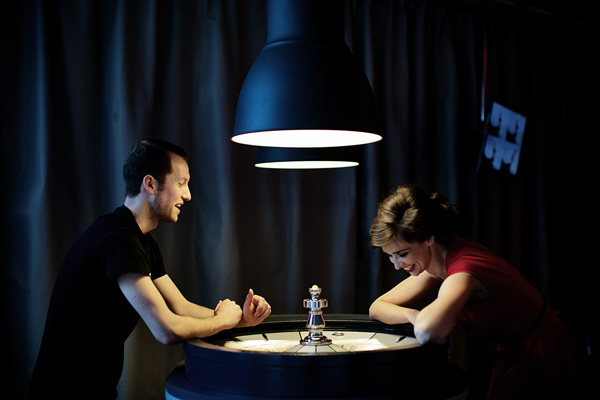(From left) Micheal John Gorman, founding director of Science Gallery, and the exhibition's co-curators Aoibheann Ní Shúilleabháin and Prof David Spiegelhalter from University of Cambridge, at the launch of Risk Lab at the Science Gallery in Dublin
What is your perception of risk? Want to learn more about the psychology and maths behind games such as roulette and poker? Well, the Science Gallery in Dublin has been transformed into a virtual casino for its latest show, Risk Lab. The goal is to help give people a deeper understanding of risk-taking in every aspect of their lives.
Risk Lab: are you feeling lucky? will open to the public tomorrow and the free show is set to run until 23 June at the Science Gallery on Pearse Street.
The theme of the exhibition is about exploring risk, coincidence, probability and chance, while visitors will also be able to engage in live experiments using custom-built slot machines.
Upon entering the gallery, the first thing a visitor will spot is a virtual casino to the right, complete with a roulette wheel and a poker table. Jessica Stanley, a researcher at the Science Gallery, said the idea behind the roulette game is to challenge people’s deep-seated perceptions about probability and luck.
A ‘Cut your Losses’ wall display depicts how casinos make money, showing the profits that are made on games such as roulette.
Take a gamble
Artist Michelle Browne will be hosting a series of live Texas Hold ‘Em games at the poker table during the exhibition. She said people will be hooked up to biometric sensors that have been developed by Dublin company Shimmer Research to monitor their physiological responses to risks they are taking during games. These sensors read galvanic skin response – a measure of stress.
“During the games I will be talking to participants about their approach to risk-taking,” explained Browne.
Another game that’s sure to get plenty of attention from the public is ‘Toppling Tower’, a large stack of blocks to replicate the game of Jenga. Here, two people will be able to play one another while also wearing biometric sensors.
Niamh O’Mahony from Shimmer Research spoke about how the sensors will measure in real-time people’s physiological reactions when they are faced with the possibility of the tower of blocks toppling.
Moving on to ‘Don’t Burst my Balloon’ – this is where people will be able to virtually bet on how much they can inflate a balloon before it pops.

Joe Roche, a mediator at Science Gallery, pictured with Aoibhinn Ní Shúilleabháin, co-curator of Risk Lab, at the roulette table
Live experiments
Stanley explained that visitors can sign-up for live experiments and get a membership card before they head to the upstairs segment of Risk Lab.
There they can sit at slot machines (these are really experiment computers) and play games about risk taking. Interestingly, the data from these experiments will be then fed back to researchers who can learn more about how people make judgments.
Other delights include the ‘Scare Booth’. This is where people will step inside a booth enveloped in darkness and their physical responses to risk will be tested.
Psychology researchers at both NUI Galway and Trinity College Dublin (TCD) have helped put the exhibition together, in addition to IBM Research.
Risk Lab is co-curated by the statistician David Spiegelhalter, who is the Winton Professor for the Public Understanding of Risk at Cambridge University, and RTÉ presenter and maths researcher Aoibhinn Ní Shúilleabháin, who is engaged in a PhD at Trinity College Dublin (TCD).
Spiegelhalter said Risk Lab will give people the opportunity to see risk in a new light.
“The exhibits are really engaging, and with luck will make people appreciate the wonders of uncertainty,” he said.
According to Ní Shúilleabháin, the show will bring to life all of the chances and possibilities we meet in our daily lives while also exploring the maths and psychology behind them.
In the following video, both curators give more insight into the exhibition, plus we take you on a tour of the show!